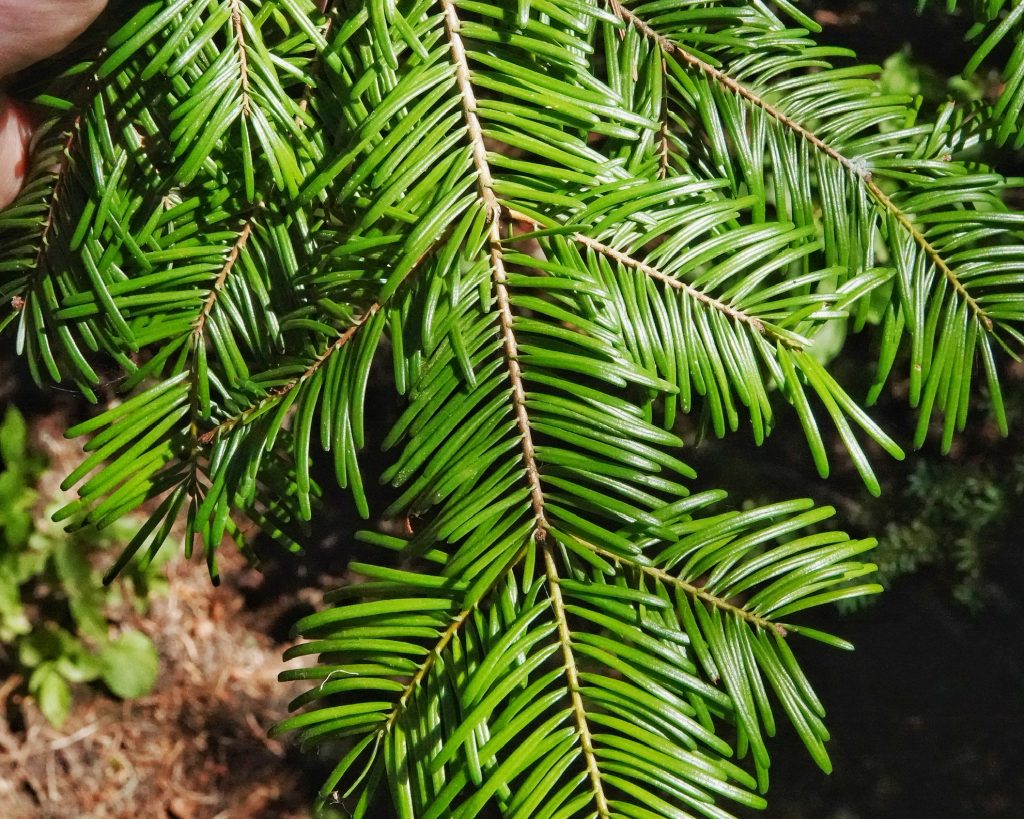
I’m finally ready to tackle the true firs in the genus Abies. There are 6 true firs in our region, but 2 of them are hybrids that I don’t think I have the expertise to differentiate. One of those, Abies magnifica x A. procera, (colloquially called Shasta red fir) is found only in the s Cascades and Siskiyous in our region, while the other, Abies concolor x A. grandis, (colloquially called hybrid white fir) is found throughout the montane regions of Oregon, c Idaho, and n California. Maybe I’ll get lucky some day and find a dendrologist who can show me some, and then I can share that with you folks.
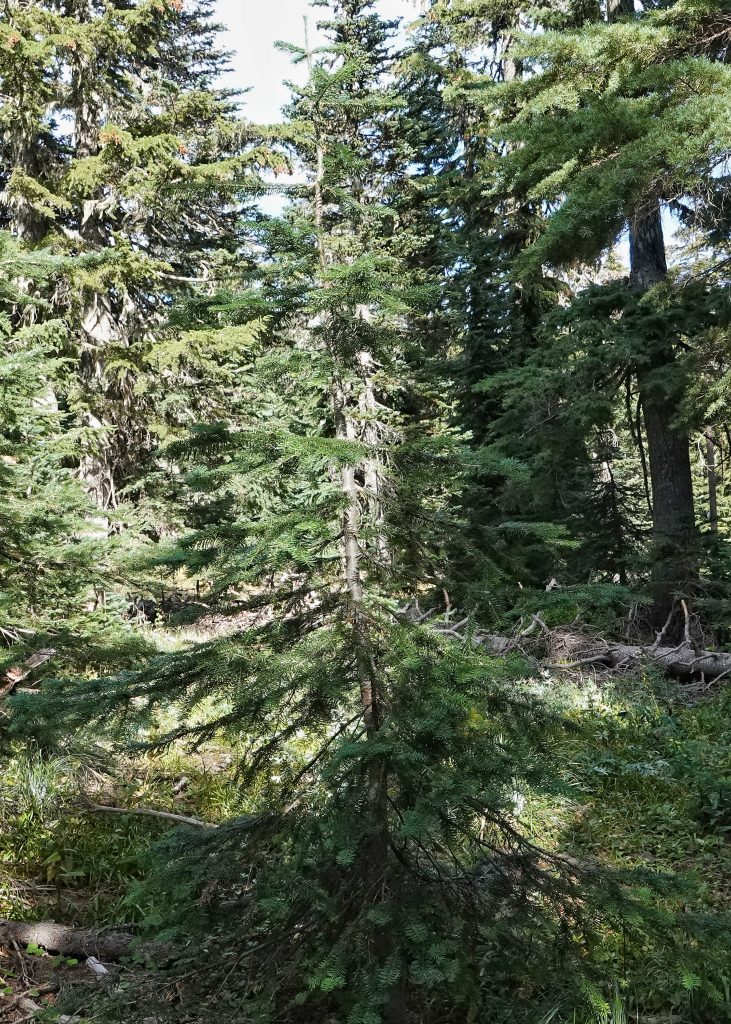
The other 4 true firs in our region break down into 2 groups for identification purposes. I’m going to start with Abies grandis (grand fir) and A. amabilis (silver fir), which only have stomatal bloom on one side of the needle, unlike A. procera (noble fir) and A. lasiocarpa (subalpine fir) which have stomatal bloom on both sides of the needles. It is harder to differentiate A. grandis from A. amabilis in theory than in practice. When I first started trying to learn the conifers I thought I knew immediately when I was looking at a grand fir. But then I read about needle length, shape, and configuration, and I became very confused. Finally I came to understand that there is a gestalt (birders call it GISS-general impression of size and shape) that is immediately recognizable for A. grandis’ needled twigs, and I now trust my first impressions.
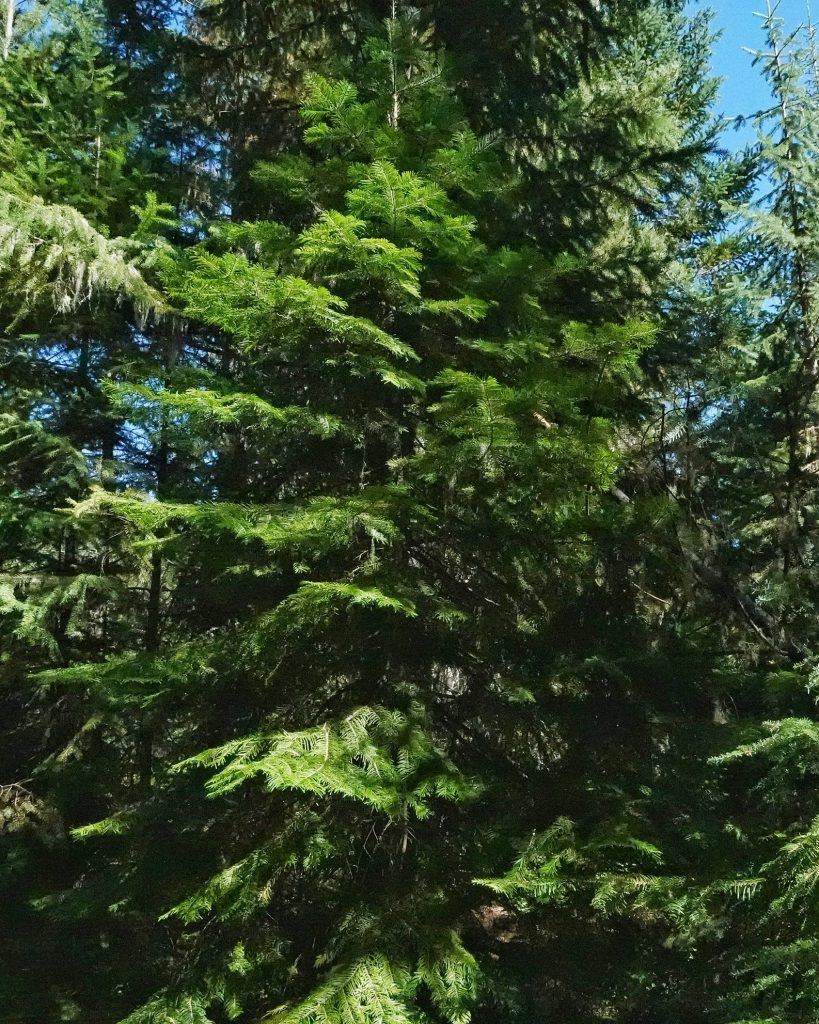
First things first- Abies spp have erect cones that disintegrate on the tree, and the scars where needles have fallen off are round to oval and slightly indented. The needles of A. grandis and A. amabilis are similar in that they both only have stomatal bloom on the underside, they’re both green on top with a groove in the center and a notched tip, and they may both be from 20-40mm long. However, A. grandis needles can be up to 50mm long, and tend to be a dark, glossy green, while A. amabilis needles are usually a softer, slightly bluish green. Grand fir twigs are more sparsely needled than those of silver fir, so that you can see the twig easily when looking from above, and the needles atop the twig are shorter than those on the sides, whereas silver fir twigs are crowded with needles, the uppermost ones obscure the twig, and they are all the same size. Most identification keys mention that grand fir needles are spreading, and in two ranks, and this is often true, at least on the lower branches. What really confused me is that somewhat higher up the outer needles frequently curve upward and bend forward, which are traits associated with silver fir needles. So the gestalt I spoke of relies on seeing that the lowermost branches have dark needles that present a low profile, through which one can easily see the twig, with the uppermost needles shorter than those to the sides.
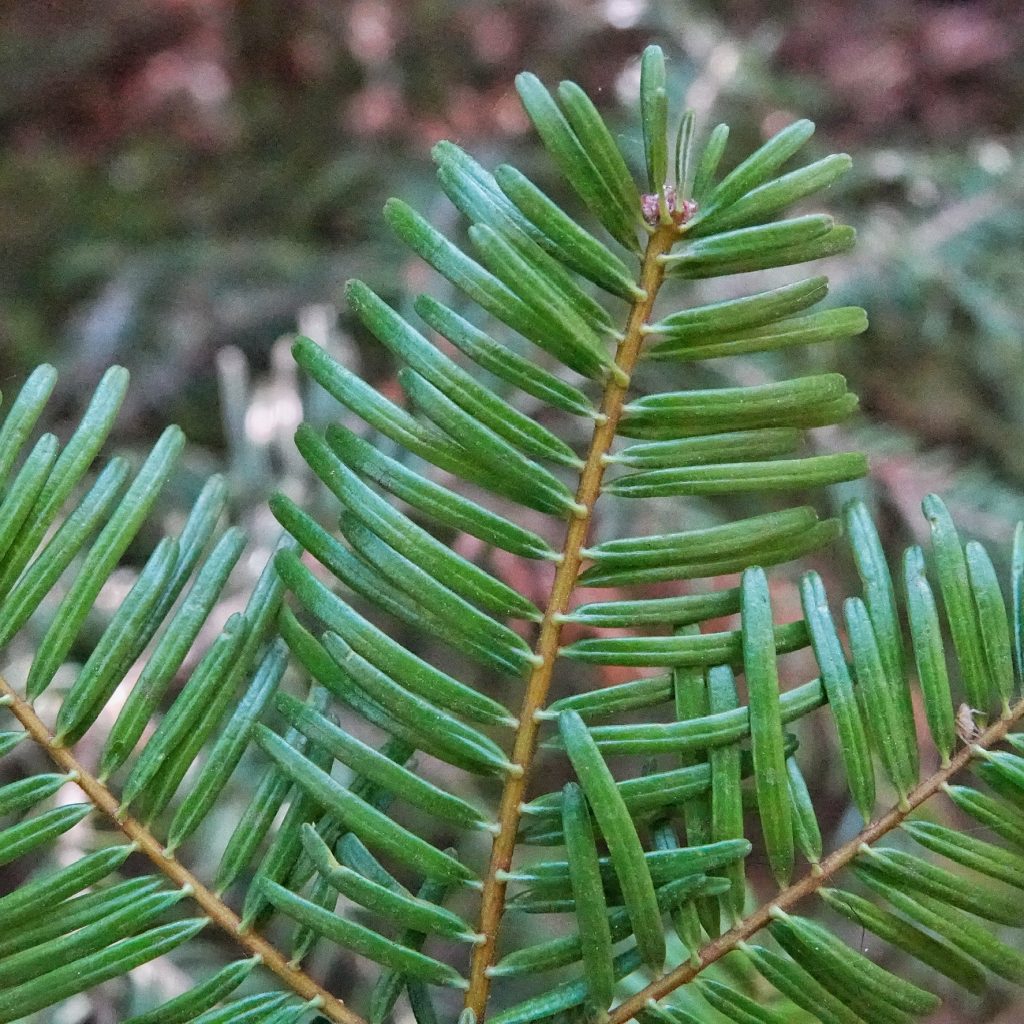
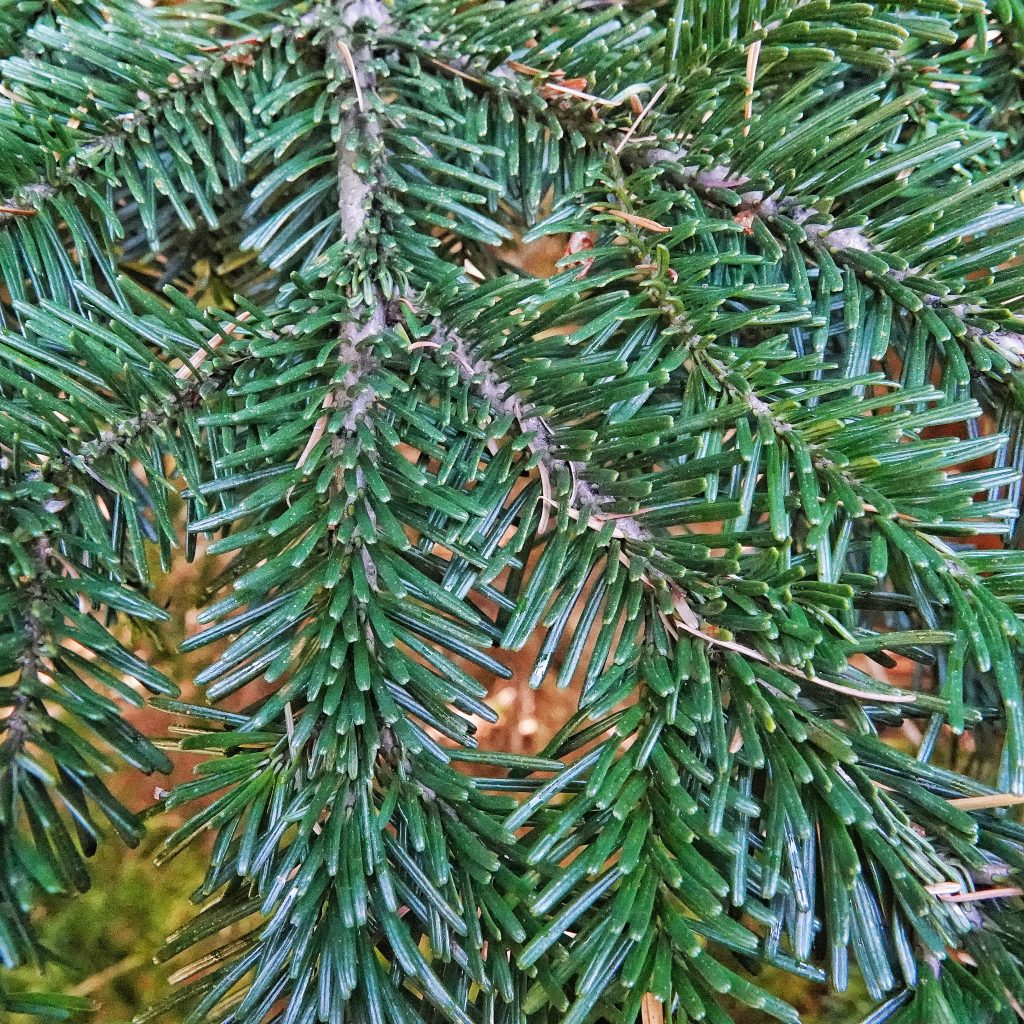
My confidence level in differentiating these two species goes way down when I can’t see the needles, because the cones of both have bracts shorter than the scales, and are said to be purplish, with A. grandis shading towards green and A. amabilis towards brown, and none of those colors are exactly in my wheelhouse. But with a really good view and the needles for scale you may be able to see that grand fir cones are smaller (2.5-4” long) and cylindrical, while silver fir cones are 3.5-6” long and barrel shaped. The bark of grand fir is said to be more furrowed than that of silver fir, and more prone to resin blisters when young, and silver fir bark is said to be more greyish white. But I’ve yet to muster a confident identification using these traits.
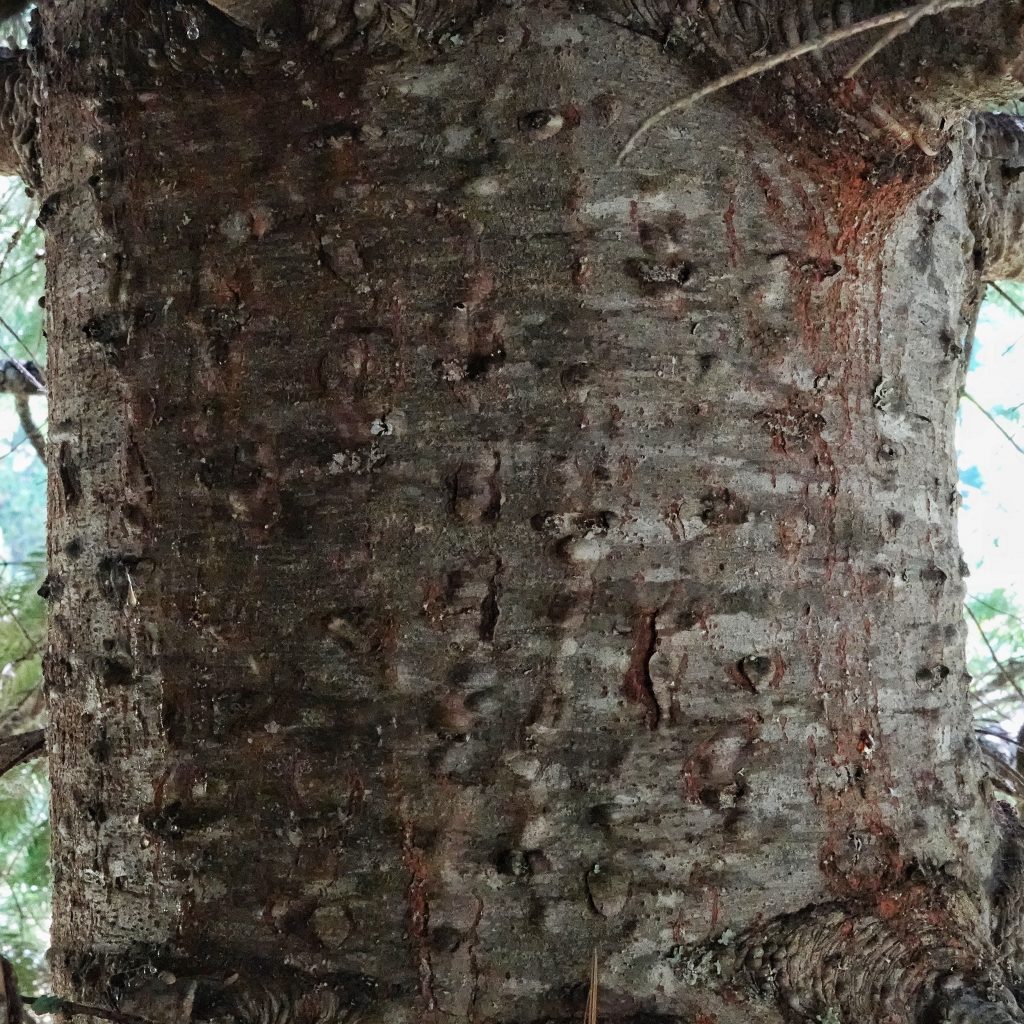
This is not a particularly long lived tree for a conifer, seldom living more than 300 years, or about half as long as Abies amabilis. Mature trees have relatively thick (up to 2”) bark, which confers a certain resistance to fires, but young trees have thin bark and are highly susceptible to fire. Grand firs have a moderately high shade tolerance, and are frequent understory trees, but will quickly take advantage of breaks in the canopy. Grand firs are not a primary target for timber harvest, because the wood is not particularly strong, and it is subject to decay, but the trees that are harvested as part of a clearcut are used for paper and pulp, and grand fir are often farmed for Christmas trees. For a much more complete picture of the natural history of this tree, see the Forest Service FEIS page for this species.

Indigenous cultures had more respect for this tree’s value, and utilized it in many ways. Pitch was used in various ways to treat eye problems and sore throats, bark, roots and twigs were used for stomach ailments and tuberculosis and a decoction of needles was used to treat colds. They also used poultices containing bark for respiratory problems, wounds and ulcers in the skin, and arthritis. As far as utilitarian purposes for this tree, the pitch was mixed with oil as a perfume, the bark was used to roof lodges, the branches for flooring and woven into ceremonial dress, the boughs to line sleeping areas and as an air freshener, logs were carved into canoes, bark was used as a dye, and hardened knots whittled for fishhooks. For a more complete list see the 76 entries in the Native American Ethnobotany Database.
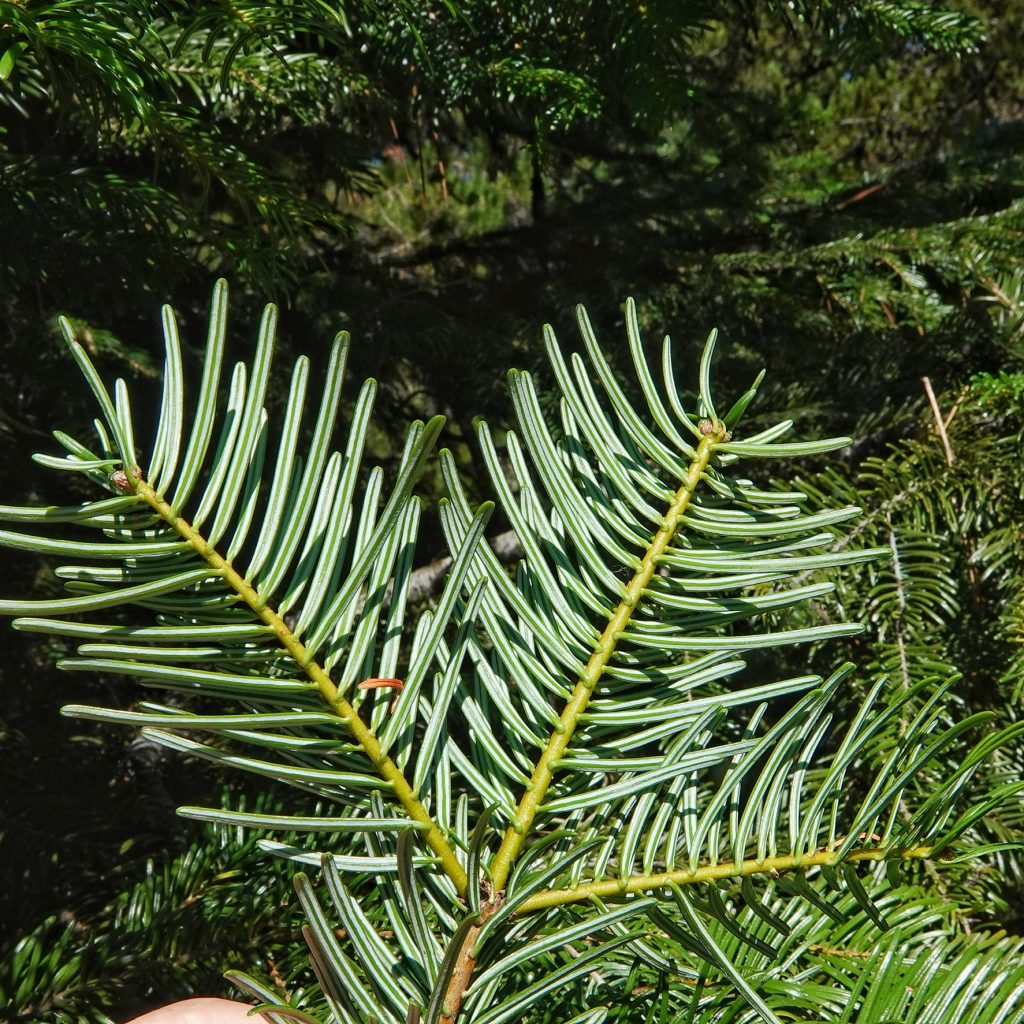
Description– Large (may be over 200’ tall and 5’ dbh) conifer with grayish brown bark, furrowed with age, needles that are spreading and of two sizes (at least on lower limbs), and upright, cylindrical cones; needles lack stomatal bloom on upper surface, which has a central groove and a notched tip; cones are greenish to purple, and lack exposed bracts.
Similar species-See above for Abies amabilis; A. lasiocarpa and A. procera have stomatal bloom on both sides of needle; Pseudotsuga menziesii, Tsuga heterophyla, and T. mertensiana have pendent cones, and slightly raised leaf scars; Spruces have persistent, peg like, leaf bases.
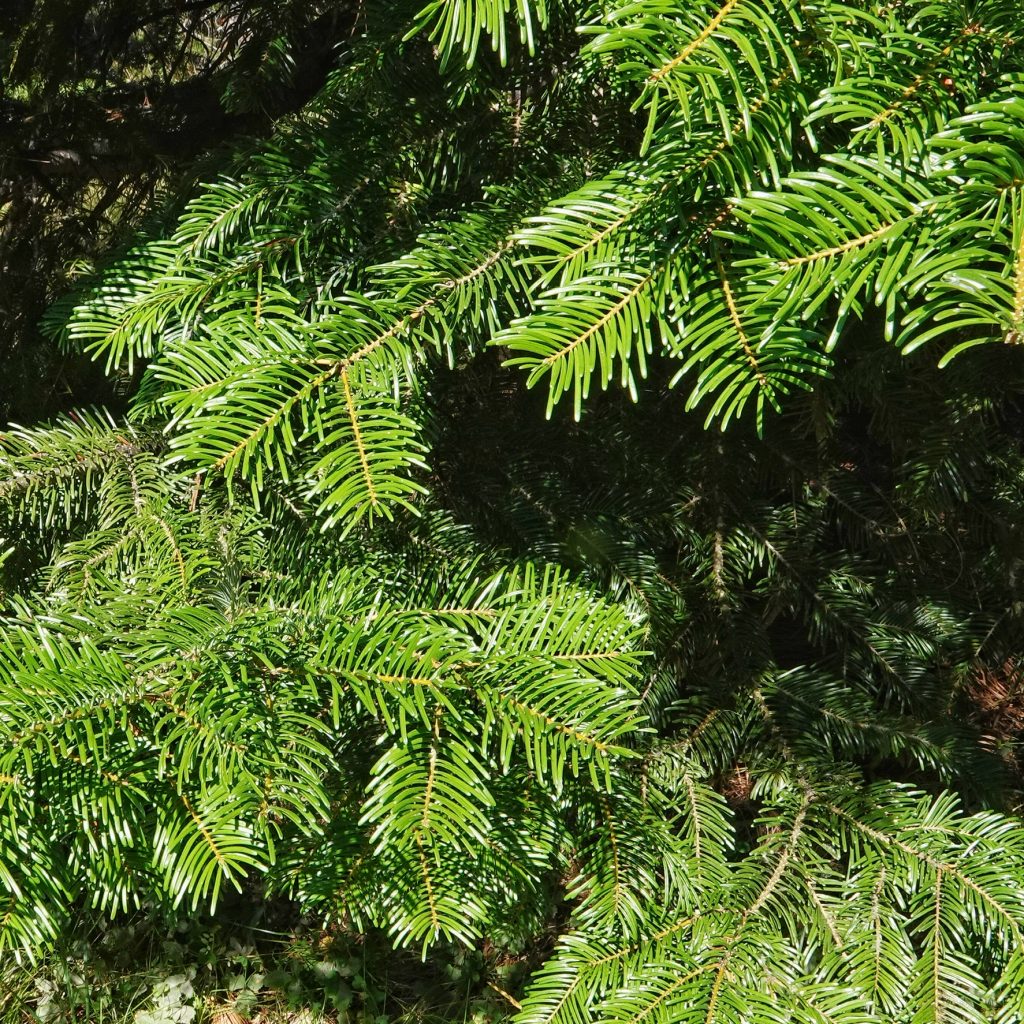
Habitat-Low to mid elevation conifer forests, usually with less than 60” of annual precipitation.
Range-Pacific Northwest; from the east slope of the Cascades to the Pacific, and in the Siskiyous, along the n California Coast, in the Blues, Wallowas, Ochocos, and the Rockies and it’s associated ranges.
Reproductive timing– Pollen is released from late March into June, depending on elevation; cones mature in August-September, and seeds are dispersed about a month later.
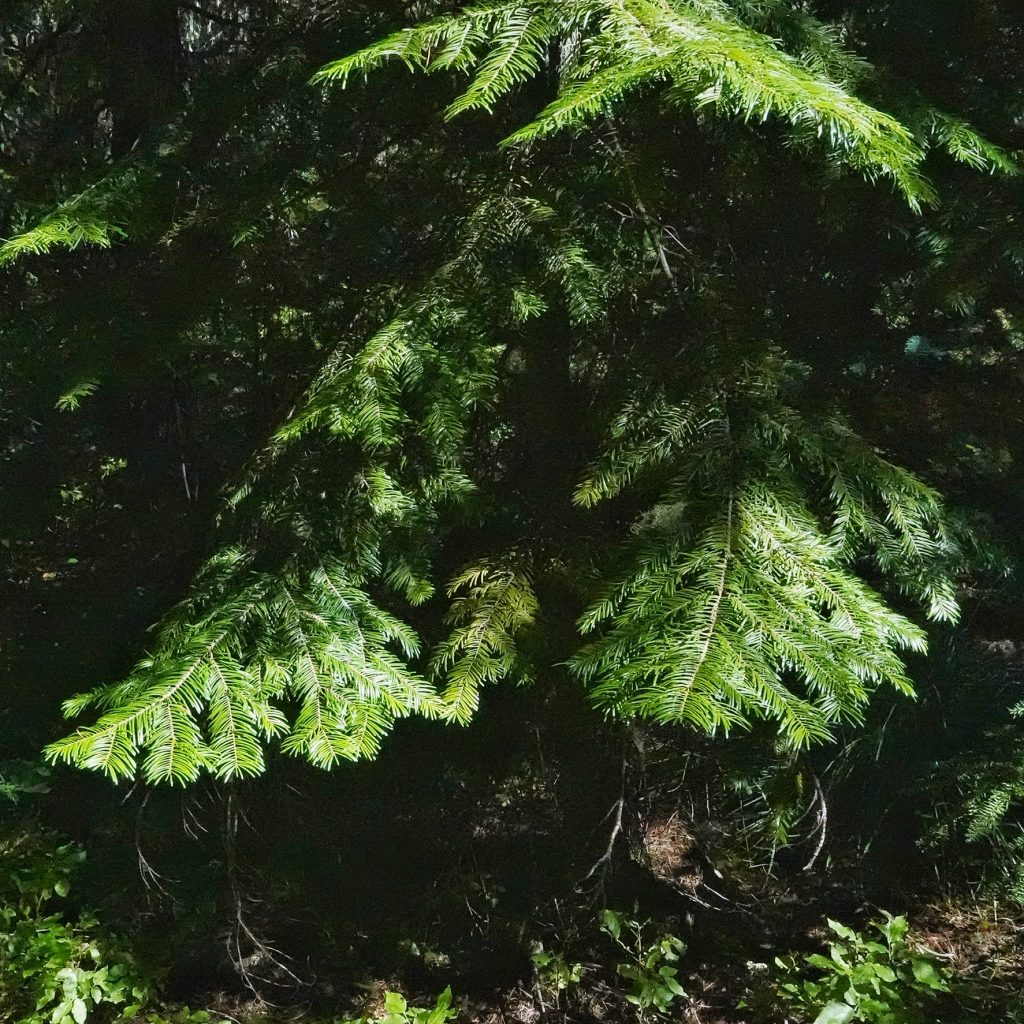
Eaten by-Grouse, nuthatches, chickadees, grosbeaks, finches, crossbills, and squirrels and chipmunks feed on the seeds; deer, grouse, sapsuckers, and woodpeckers may consume the foliage; porcupines eat the bark; true bugs in the family Adelgidae, with Adelges picea being a pest species in Christmas tree farms; larvae of wood wasps in the genus Sirex; larval host for over 50 species of Lepidoptera, including Pine White butterflies, and the moths Dasychira grisefacta, Orgyia pseudotsugata, Cosmia praeacuta, Egira perlubens, Panthea virginarius, Peridroma saucia, Spiramater lutra, Syngrapha alias, S. celsa, Xestia mustelina, Barbara colfaxiana, Epinotia radicana, Epiphyas postvittana, Lophocampa argentata, Antepirrhoe fasciata, Caripeta divisata, Enypia griseata, E. packardata, E venata, Epirrita autumnata, Gabriola dyari, Hydriomena irata, H. speciosata, Nepytia phantasmaria, N. umbrosaria, Operophtera bruceata, Speranza lorquinaria, Tetracis pallulata, Thallophaga hyperborea, as well as several species of Pero and Eupithecia; Prionus californicus larvae feed on the roots of healthy and moribund trees; adults and larvae of the bark beetle Scolytus ventralis feed on the phloem of living trees; larvae of the longhorn beetles Clytus planifrons, Etorofus obliteratus, Monochamus obtusus, Opsimus quadrilineatus, Poliaenus oregonus, Rhagium inquisitor, Semanotus litigiosus, Stictoleptura canadensis cribripennis, Ulochaetes leoninus, Xestoleptura crassipes, Xylotrechus undulatus feed beneath the bark of, mostly, stressed, moribund, and dead trees, as do a variety of Buprestidae spp.; ambrosia beetles in the genera Xyleboros, Trypodendron, and Gnathotricus create galleries in (usually) moribund or dead trees into which they introduce ambrosia fungi on which they feed.
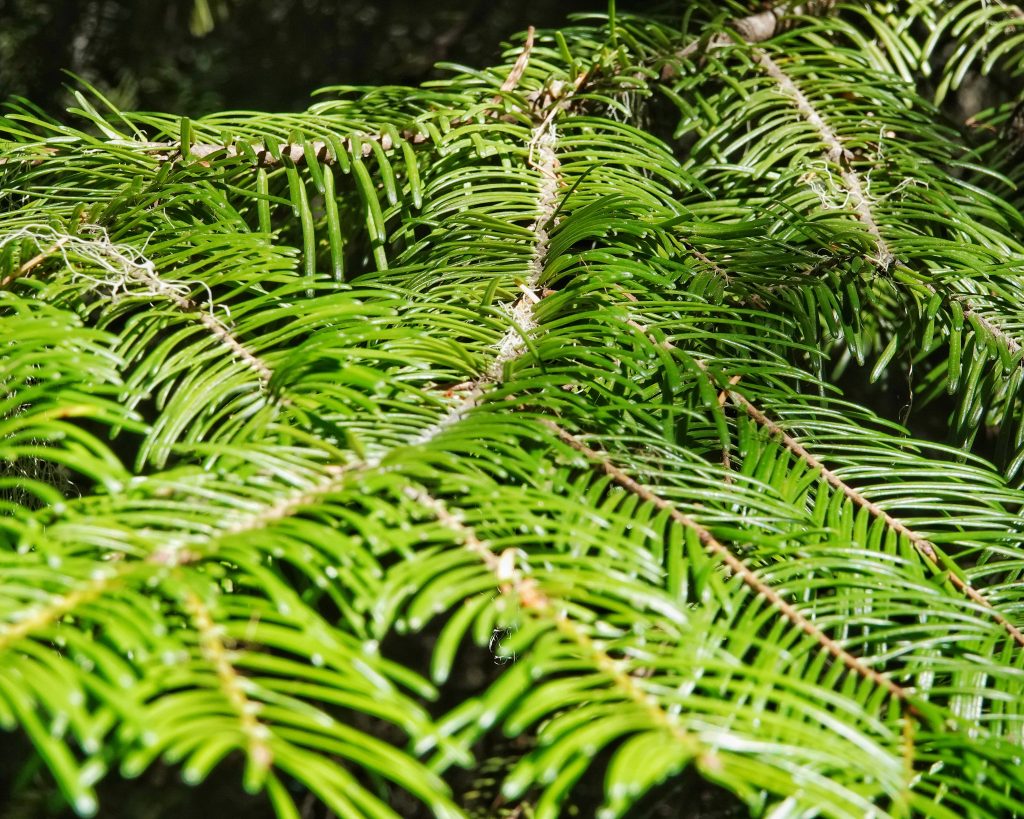
Etymology of names– Abies is the Latin word for ‘firs’. The specific epithet grandis is from the Latin word for ‘large/great/magnificent’, any and all of which are applicable and were probably uppermost in David Douglas’ mind when he described this species.
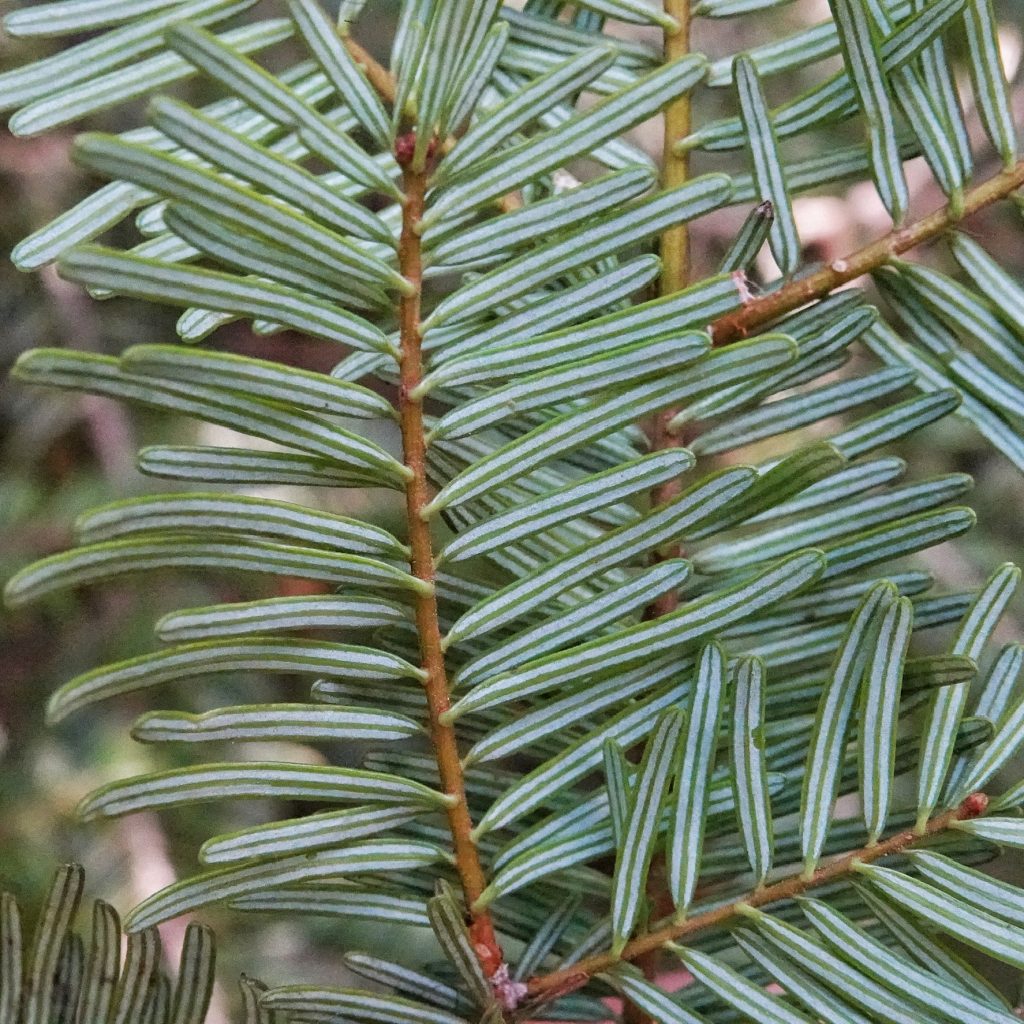
Abies grandis (grand fir) description
BRIT – Native American Ethnobotany Database
Abies grandis | Landscape Plants | Oregon State University
http://nativeplantspnw.com/grand-fir-abies-grandis/
Burke Herbarium Image Collection

Wow! Thanks for this series. You are so much more informative than the general guides that are published.
Thank you so much for saying that , Michael! One advantage I have is that I have no space constraints.
Hi Dan
Let’s not neglect the highly distinctive fragrance that emanates from the crushed needles of Silver Fir versus Grand Fir. Smell them once, and you’ll never confuse these two species again – night or day!
I saw that in a few places, and I crushed and smelled a lot of fir needles, but I could never smell much difference, so I didn’t mention it. One book even described the odor of amabilis as foetid, but it smelled great to me. What do they smell like to you?
Hmmm. Interesting. To me, amabilis smells like spring tonic, grandis like something you’d wash your floors with, and lasiocarpa like bathroom deodorizer. But maybe it’s just me then…
Sounds like you have a more educated nose than me! 30+ years of smoking probably has something to do with that.
But I’m sure that will be of some use to the readers, so thanks for the clarification!